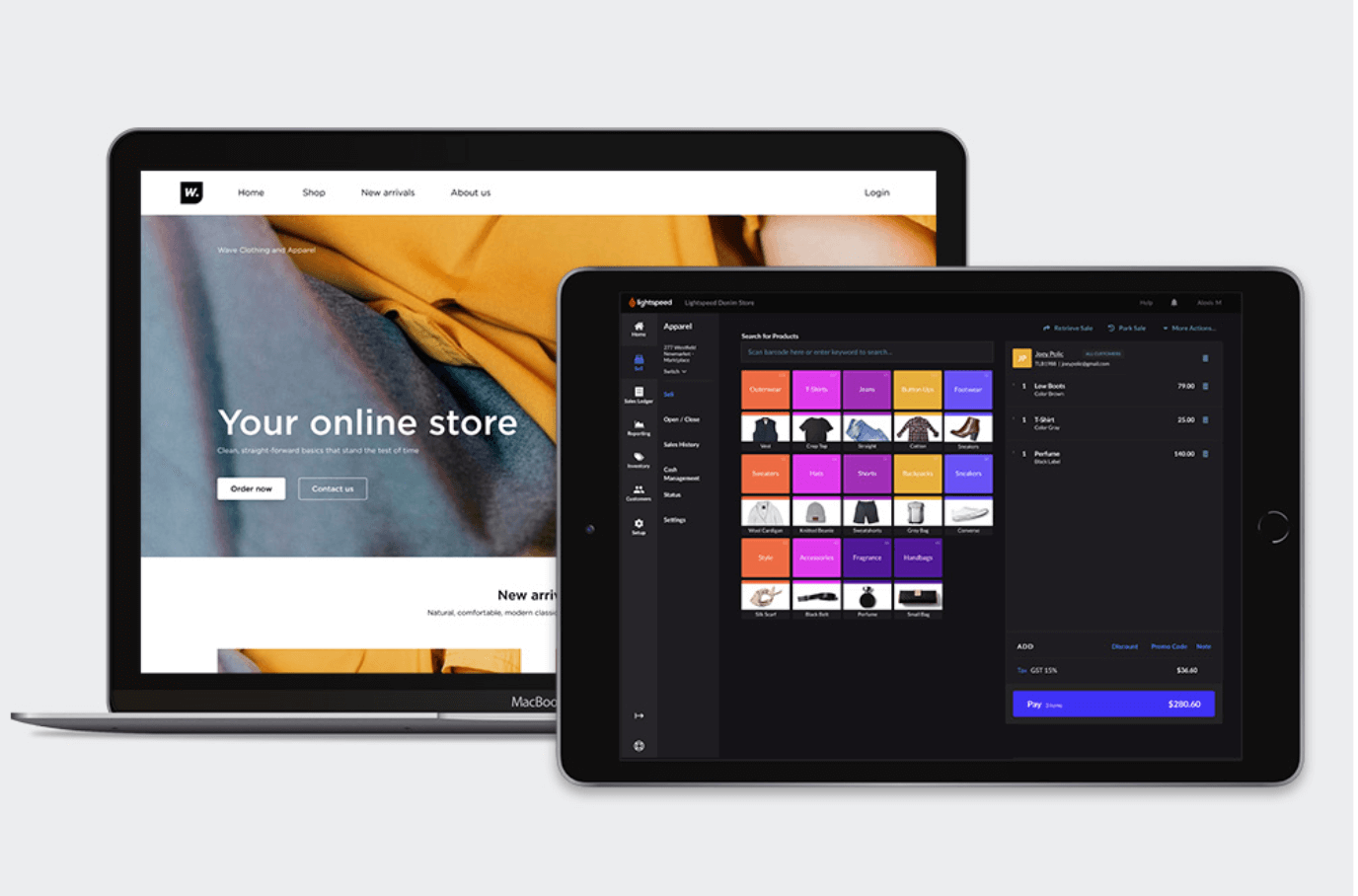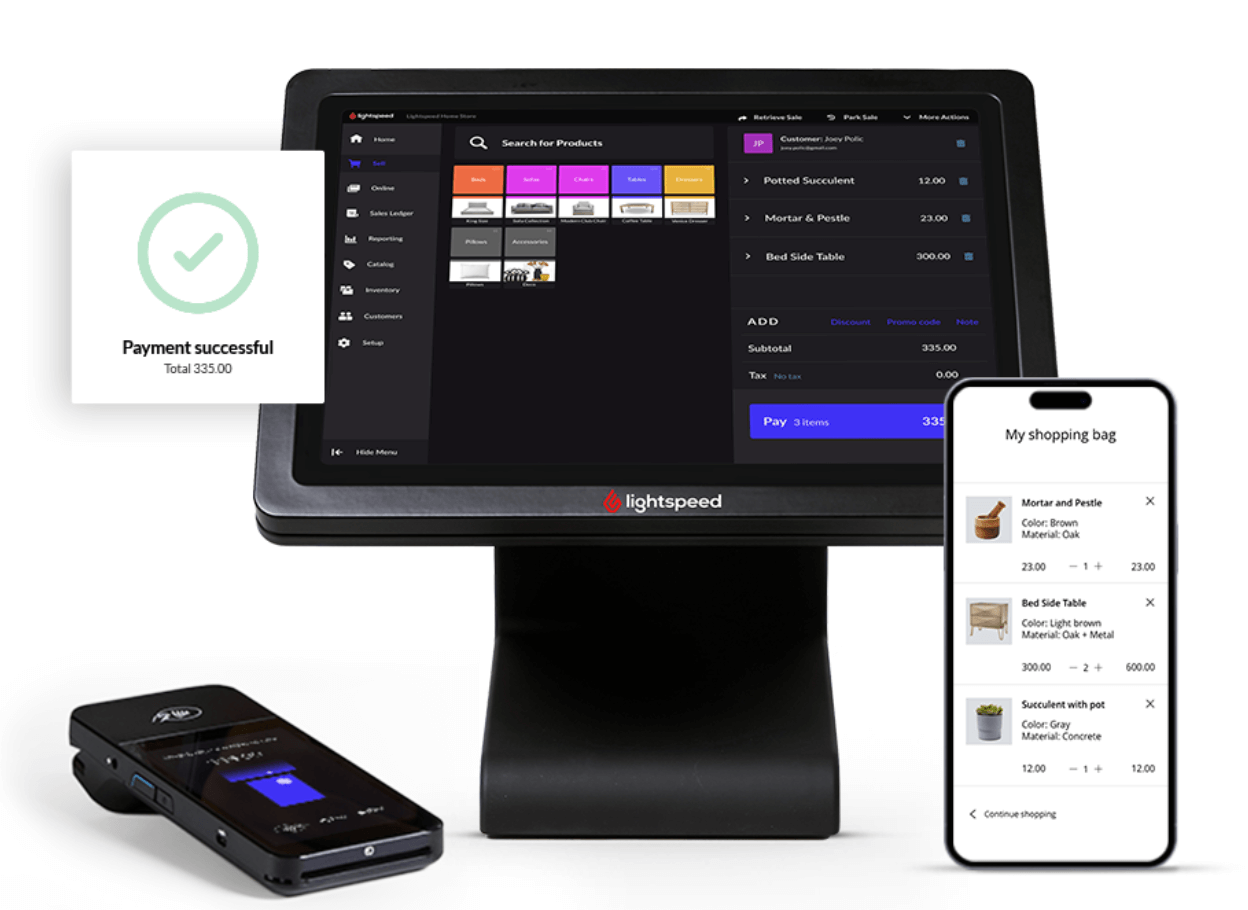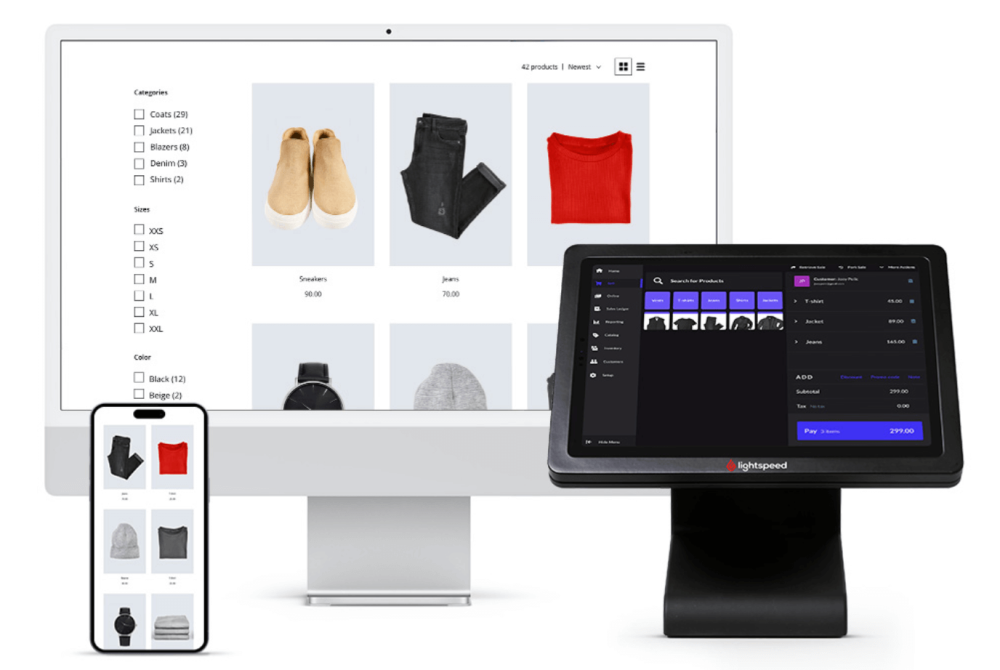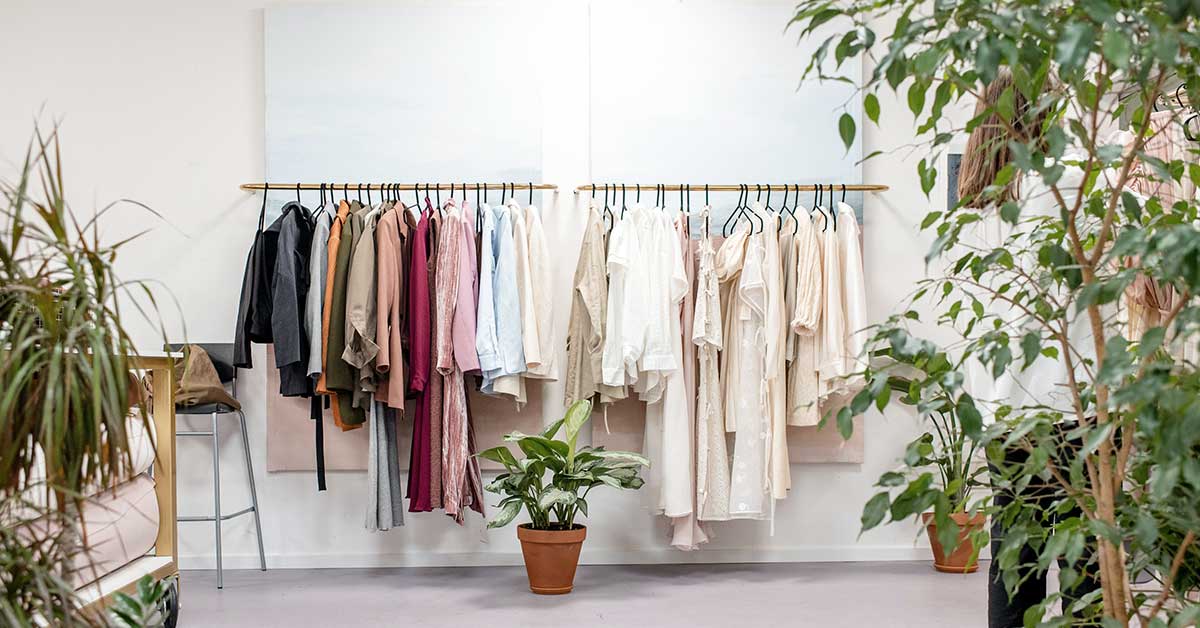
Boutiques are the heart and soul of the retail world. Independent shops never miss a beat when it comes to keeping up with trends, and they carry unique items you can’t find anywhere else. If you’ve always dreamed of opening up your own specialty store, this guide on how to start a boutique is for you.
You’ll learn about:
- The state of boutiques in 2024
- Deciding what to sell at your boutique and how to source inventory
- How to pick a location for your shop and design its interior
- Ways to market your business and build a brand
- How to choose a POS system for your boutique
- Understanding your target market
- Legal considerations for starting a boutique
- Financing your boutique
Prepare your business for the future of commerce
Download our free playbook and learn how to sell on different channels, boost loyalty and increase foot traffic with technology.
The state of in-person retail in 2024
Amid skyrocketing prices due to factors like inflation, consumers are being more careful with their shopping habits. According to McKinsey, they’re buying less per trip in categories like health and beauty and household items.
Consumers may be shopping more, but they’re buying less each trip.
Retail industries reflect these patterns: the clothing boutique space, for example, reached $32 billion in revenue last year. That’s a large number, but relative to overall economic growth, the industry has been growing slowly.
We all know the retail industry has changed rapidly over the past few years. Plus, as McKinsey reports, there’s been a boom in online retail and social selling. That means businesses of all types have to adopt new selling strategies.
Boutiques benefit from building loyal local customer relationships. People like supporting local independent businesses, and this can make a great impact on boutique sales.
However, this can also affect some boutiques’ ability to transition to a wider online market and create new revenue streams. Thankfully, there are ways for boutique businesses to maintain their independent identities while creating new revenue streams.
How to decide what to sell at your boutique and how to source inventory
If you want to know how to start a boutique, the first step is to decide what to sell in your shop and then figure out where you’ll get those items.
What to sell
There are several ways to figure out what to sell when opening up a retail store. While you’ll probably fare better if you sell something that you’re passionate about instead of something you have no interest in, you have to make sure that there’s demand for your wares.
Conduct market research to gauge interest. You can hire a market research firm to help you get started, or you can do your own research by interviewing potential customers. You should also visit competing shops and observe what they have in stock, what seems to sell well and what’s missing.
Sourcing inventory
One way to source inventory for your boutique is to make the inventory yourself. If you’re crafty and have the time, this DIY approach can be a good way to create your starting inventory on a budget. As you get busy with your successful retail business, you’ll no longer have time to hand-make every candle, bar of soap, cake mix, or whatever you end up selling.
If you’re still interested in selling your own wares but don’t have the bandwidth to produce them, your best bet is to work with a manufacturer who can mass-produce the items you plan to sell.
To diversify your boutique, you can also sell other people’s products. Source items directly from creators, like artisans and designers, or buy products from wholesalers.
Here’s a handy table that breaks down all the ways you can source inventory:
| Source | Description | Pros | Cons |
| Wholesalers | Purchase bulk inventory from wholesalers | Wide variety of products | Limited customization options |
| Designers | Work directly with designers for unique items | Exclusive and unique inventory | Higher costs and limited selection |
| Trade Shows | Attend trade shows to discover new products | Access to trendy and niche items | Travel expenses and time-consuming |
| Manufacturers | Source directly from manufacturers | Lower cost due to bypassing middlemen | Large minimum order quantities may be required |
| Consignment | Sell items on consignment | No upfront cost for inventory | Potentially lower profit margins and risk of unsold items |
| Handmade | Create or commission handmade items | Unique and artisanal products | Higher production costs and limited scalability |
How to pick a location for your boutique and design its interior
Make your dream a reality by setting up shop. Find the perfect location, then, create a setting that will keep shoppers coming back for more. This is one of the most common questions about how to start a boutique that prospective merchants ask. But don’t worry, it’s simpler than you’d think.
Choosing a location for your boutique
Location will play an important role in your business’s success. Opening a boutique in an area with plenty of foot traffic and near public transportation, or with lots of car traffic and accessible parking, will help attract customers. A premium location will come with a premium price, but it will mean you’ll have to spend less on marketing and advertising.
Visibility is also important. If your boutique is in an ideal location, but your storefront is hidden in an alley or its sign is obscured by a tree or building, customers may have a difficult time finding it. Choose a space that’s easy to locate.
Finally, consider proximity to complementary businesses. If you open a workout gear boutique next to a gym or a baby clothing shop next to a daycare center, you’ll generate business without lifting a finger.
Designing your boutique
When starting a small business, you’ll want to make sure your store’s design matches your branding. Use your brand’s logo and colors throughout the store to bolster brand recognition.
Then, make your shop stand out with an eye-catching mural, wallpaper or window display that encourages shoppers to come in, snap a photo, and spend time browsing.
Design your store’s layout, windows, fitting rooms and displays so that they encourage shoppers to spend. Familiarize yourself with visual merchandising tactics to understand how displays affect purchasing decisions.
How to brand and market your boutique
Want to know how to attract customers? Branding and marketing are the keys to gaining a loyal customer base.
Creating a brand
Branding can help differentiate your boutique from other shops that sell the same or similar items. It can be the reason someone chooses to buy something from you instead of from the competition or a big-box retailer.
Your brand should be easily recognizable and should make shoppers feel a certain way. It should be reflected in every aspect of your boutique, from its logo and shopping bags, to your shop’s signature scent and the way your staff interact with customers, and even your ecommerce shop’s design and social media presence.
To create your brand, start by thinking about your mission. Why are you starting this business? Is it to provide people with a destination for sustainable clothing and products for their babies and children? Is it to empower artists from marginalized communities by selling their work? Keep your mission at the core of all of your business and design decisions to build a strong brand.
Consider Toronto-based slow fashion boutique Coal Miner’s Daughter. With several locations, they sell and support independent Canadian fashion labels and focus on sustainability and ethical practices.
Entering their store or visiting their socials, you can immediately see that their brand is consistent and reflective of their principles. They make use of natural lighting, a neutral color palette and a calm, woodsy interior to make a cohesive brand.
View this post on Instagram
Marketing your business
If you think you can stop marketing your business after its grand opening, think again. Even if business is good now, you should actively keep your boutique atop customers’ minds to ensure a steady flow of sales.
Combine any number of these marketing techniques to keep shoppers interested:
- Create eye-catching window displays. Window displays can turn a passerby into a customer. Take inspiration from the changing seasons, from your products and even from Pinterest. Change your displays regularly to indicate that you have new items for shoppers to check out.
- Update social media regularly. Maintain an active social media presence for your boutique to keep followers intrigued, engage with customers and source ideas for products. Instagram, Facebook and TikTok are staple platforms. There, you can also create content that displays your products or demonstrates helpful tips related to them.
- Work with influencers. Customers are more likely to trust recommendations from their peers than advertisements. Partner with influencers to spread the word about your boutique. Invite bloggers and social media influencers to a private shopping event at your store, or send them products or gift cards in exchange for publicity.
- Leverage email and SMS marketing. When your boutique implements a loyalty program, you can use it to automatically send your customers promotional offers via email or SMS that will get them back in the door and spending more.
Read our in-depth article on hiring the right influencers for your brand.
How to choose a POS system for your boutique
Your point of sale (POS) system is the hub of all of your business’s transactions, and can impact the success of your boutique. Look for an all-in-one retail POS and payment processing system that has the following features to help your business grow.
Omnichannel capabilities

As we mentioned earlier, if you’re not selling online, you may fall behind. Thankfully, a good POS and payments system will make it easy to sell online and at your shop by storing all transaction, customer and inventory data in one place. With the ability to view and manage all your operations in one place, you can run your boutique’s revenue streams much more efficiently. Selling online and off becomes easier when you work on a system that allows you to create personalized workflows, take payments and much more.
Reporting and analytics
Your POS and payments platform should give you access to real-time reporting, whether you’re at your boutique or on the go. Armed with these insights, you can make high-level business decisions in order to maximize selling. You’ll also be able to serve your customers’ needs better when you understand their buying decisions. Plus, employee and sales reports can help you save on overhead costs by allowing you to create schedules that match peak sales hours. You should also find a POS that allows you to compare reports from different periods, so you can understand trends and consumer behavior over time.
Here’s an idea of the types of reports you should be able to generate to get a better view of your business:
- Product performance
- Inventory reports (dusty inventory, sell-through, replenishments, etc.)
- Sales reports by time (month/day/hour)
- Employee reports
- Top customer reports or customer groups
Payment processing

Using a POS system that has built-in payment processing will streamline your operations. This way, instead of sending your customers to third-party processors or juggling multiple provider accounts, you can easily ring up sales and get paid within one united system. Not only that, but you’ll have all your payment and sales information in one convenient place.
Inventory management

Look for a point of sale system that makes it easy to keep track of what you have in stock, what’s selling like hot cakes, what you need to reorder and more. This way, you can avoid overstocking, avoid running out of popular items and automatically schedule inventory orders, allowing you to maximize your sales.
Understanding your boutique’s target market
Before opening your boutique, it’s crucial to understand your target market–the specific group of customers you aim to attract and serve. There are a few ways to achieve this.
Conduct market research
Start by conducting thorough market research. Identify demographics, preferences and shopping behaviors of your potential customers. Consider factors such as age, gender, income level, lifestyle and fashion preferences. Analyze market trends so you can identify your target market. You may already have a specific market in mind before you start your research, or you may be searching for the best fit. Market research will help you narrow down your ideal customer base.
Tailor your offerings accordingly
Understanding your target market allows you to tailor your product selection, pricing, and marketing efforts to resonate with your audience. For example, if your boutique caters to young professionals, you might focus on trendy, professional attire at mid-range prices. If your target market is eco-conscious consumers, you could emphasize sustainable and ethically sourced products.
Keep learning about your customer base
Regularly engage with your target market through surveys, social media and in-store interactions to gather feedback and insights. By continuously refining your understanding of your audience, you can adapt your offerings to meet their evolving needs and preferences, fostering long-term loyalty and success for your boutique. Use customer data and reports to understand which products are selling and overall trends.
Legal considerations for starting a boutique
As with any business, starting a boutique requires you to comply with local, state and federal regulations.
Decide your boutique’s structure
First, you’ll need to choose a legal structure for your business, such as a sole proprietorship, partnership, LLC or corporation. Each structure has different tax implications, liability protections, and requirements. Consult with a legal professional to determine the best option for your boutique.
Get the right permits
You’ll also have to obtain the required permits and licenses to operate your boutique legally. This can include:
- Business license
- Sales tax permit
- Zoning permits
- Health permits if you plan to sell food or beverages
- Signage permit
- Music license (if applicable)
- Fire department permit
If you don’t comply with these regulations, you may face fines, penalties or even forced closure of your business.
Make sure you trademark
It’s also a good idea to protect your intellectual property by trademarking your boutique’s name and logo, as well as any unique designs or products you create. Consider drafting contracts for suppliers, employees and landlords to clarify rights, responsibilities and obligations.
How to finance your boutique
Financing is a critical aspect of starting a boutique. It determines your ability to secure a location, purchase inventory, and cover operating expenses until your business becomes profitable. Talk to a financial advisor and outline a detailed budget before you make any financing decisions.
There are several financing options available to aspiring boutique owners:
- Personal savings: if you have saved money to fund your business, you may want to start here to get up and running before you supplement with other options.
- Bank loans: you can apply for a business loan at your bank. Remember that you’ll likely have to offer collateral and a detailed business plan, so plan your application ahead of time.
- Small Business Administration (SBA) loans: this is a federal program that makes it easier for small businesses to access funding. It’s a great option for those just starting out.
- Line of credit: this is a flexible form of financing that gives businesses access to funds on an as-needed basis.
Other options include crowdfunding and loans from family or friends.
No matter which form of funding you choose, consider creating a comprehensive business plan that outlines your boutique’s goals, target market, competitive analysis, marketing strategy and financial projections. This document will help lenders and investors understand your business’s viability and potential for success.
When considering financing options, carefully evaluate the terms, interest rates, repayment schedules and associated fees to choose the option that best aligns with your financial situation and business objectives. Remember that starting a boutique requires not only initial funding but also ongoing financial management to ensure long-term sustainability and growth.
Wrapping up: How to start a boutique
Now you know all that you need to know about how to open a boutique. There are many factors to consider, but we’re confident that with the right tools and resources, you can get your boutique up and running in no time.
Looking for a POS and payments system that will set your boutique up for success? Talk to a Lightspeed expert today to get started.
FAQ
1. How much does it cost to start a boutique?
The cost of starting a boutique can vary widely depending on location, size, inventory and decor. Generally, it could range from $10,000 to $100,000 or more.
2. How profitable is a boutique?
Boutique profitability depends on factors like location, target market, pricing strategy and operational efficiency. Successful boutiques can be quite profitable, with margins ranging from 30% to 70%.
3. What do I need to do to start a boutique?
To start a clothing boutique, you’ll need a solid business plan, funding, a suitable location, inventory, permits/licenses and marketing strategies.
4. How do boutiques get their clothes?
Boutique owners source clothes from various suppliers such as wholesalers, designers, trade shows or directly from manufacturers. Some also opt for consignment or handmade items.
5. How do boutique owners pay themselves?
Boutique owners typically pay themselves through a combination of salary, profits and reinvestment into the business. The exact method varies based on individual financial goals and business structure.
6. How many items should you start a boutique with?
Starting with a diverse inventory of around 100-300 items is common. It allows for a good selection without overwhelming your space or budget.
7. How long does it take a boutique to make money?
The time it takes for a boutique to become profitable varies. It could range from a few months to a couple of years depending on factors like location, market demand, marketing efforts and operational efficiency.

News you care about. Tips you can use.
Everything your business needs to grow, delivered straight to your inbox.



![11 Tips To Make Your Pop-Up Shop a Roaring Success [For Retail Store Beginners and Pros Alike]](https://blog-assets.lightspeedhq.com/img/2021/06/2da3ae10-blog-hero_pop-up-shop.jpg)